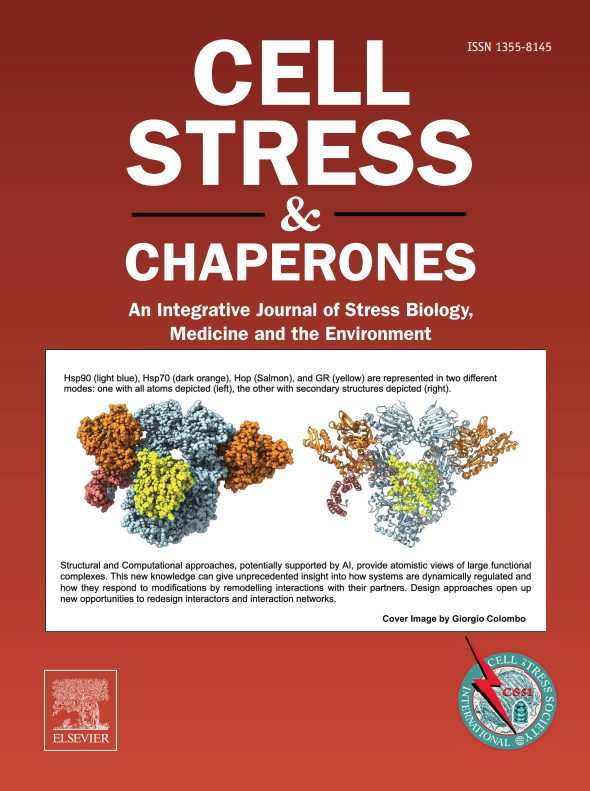Pathogenic mechanism of the K141E mutation in HSPB8: Insights from smFRET and simulations
IF 3.2
3区 生物学
Q3 CELL BIOLOGY
引用次数: 0
Abstract
Pathogenic mutations can have a large impact on the conformational ensemble of intrinsically disordered proteins, but revealing those effects and their physiological relevance can be challenging. We used large-scale all-atom explicit-solvent molecular dynamics simulations and single-molecule Förster resonance energy transfer (smFRET) experiments to investigate the conformational dynamics of the chaperone protein HSPB8 and its K141E mutant that is linked to motor neuropathies. Our findings revealed that the HSPB8-K141E mutant exhibits increased conformational flexibility compared to the wild-type protein, particularly at high physiological ionic strengths, leading to a more extended conformational ensemble. Bayesian maximum entropy reweighting was applied to improve agreement between simulated and experimental smFRET data, further emphasizing the mutation’s influence on protein dynamics. While both WT and K141E showed similar primary smFRET peaks after reweighting, the mutant displayed a higher occurrence of a secondary peak at lower FRET, indicative of an unfolded state. Additionally, differences in salt bridge networks between the variants highlighted the role of ionic interactions in modulating protein structure and suggest a possible connection between rapid dynamics and conformational stability. These results suggest that the pathogenicity of the K141E mutation may be, at least in part, due to the enhanced conformational variability that negatively influences the protein function. The study underscores the significance of ionic strength in the structural dynamics of intrinsically disordered proteins like HSPB8, providing insights into the functional implications of these changes and how stability changes can manifest across different timescales.
HSPB8中K141E突变的致病机制:来自smFRET和模拟的见解。
致病性突变可以对内在无序蛋白质的构象集合产生很大影响,但揭示这些影响及其生理相关性可能具有挑战性。我们使用大规模的全原子显式溶剂分子动力学模拟和单分子共振能量转移(smFRET)实验来研究与运动神经病变相关的伴侣蛋白HSPB8及其K141E突变体的构象动力学。我们的研究结果表明,与野生型蛋白相比,HSPB8-K141E突变体表现出更高的构象灵活性,特别是在高生理离子强度下,导致更广泛的构象集合。采用贝叶斯最大熵重加权来提高模拟和实验smFRET数据的一致性,进一步强调突变对蛋白质动力学的影响。虽然WT和K141E在重新加权后都显示出相似的初级smFRET峰,但突变体在较低的FRET处显示出更高的次级峰,表明未折叠状态。此外,变体之间盐桥网络的差异突出了离子相互作用在调节蛋白质结构中的作用,并表明快速动力学和构象稳定性之间可能存在联系。这些结果表明,K141E突变的致病性可能,至少部分是由于增强的构象变异性,这对蛋白质功能产生了负面影响。该研究强调了离子强度在HSPB8等内在无序蛋白的结构动力学中的重要性,为这些变化的功能含义以及稳定性变化如何在不同时间尺度上表现出来提供了见解。
本文章由计算机程序翻译,如有差异,请以英文原文为准。
求助全文
约1分钟内获得全文
求助全文
来源期刊

Cell Stress & Chaperones
生物-细胞生物学
CiteScore
7.60
自引率
2.60%
发文量
59
审稿时长
6-12 weeks
期刊介绍:
Cell Stress and Chaperones is an integrative journal that bridges the gap between laboratory model systems and natural populations. The journal captures the eclectic spirit of the cellular stress response field in a single, concentrated source of current information. Major emphasis is placed on the effects of climate change on individual species in the natural environment and their capacity to adapt. This emphasis expands our focus on stress biology and medicine by linking climate change effects to research on cellular stress responses of animals, micro-organisms and plants.
 求助内容:
求助内容: 应助结果提醒方式:
应助结果提醒方式:


